Alpaca Expeditions Review: Hiking The Inca Trail The Best Way Possible

Choosing a company for the Inca Trail is overwhelming. There are quite a lot – all with slightly different benefits. We hiked the 4 day Inca Trail to Machu Picchu with the amazing Alpaca Expeditions. Which I why I feel the need to do an Alpaca Expeditions Review. I honestly couldn’t have imagined a better company to do this with!
And before you start to wonder: this is not a sponsored post in any way. Alpaca Expeditions is in no way involved in deciding to write this. It’s all me!
Let’s dive right into this review – and unravel the greatness of the Inca Trail with the expert guidance of Alpaca Expeditions.
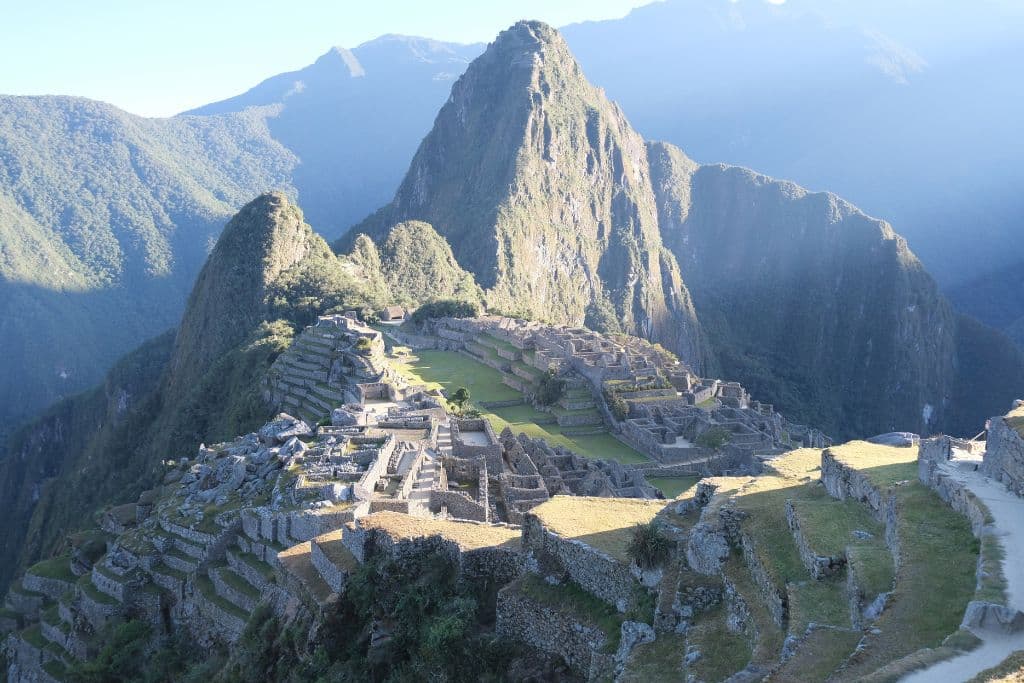
Alpaca Expeditions Review – Our Experience
After travelling for about 8 months, we got to Peru. And let’s just say we’ve experienced quite some tour companies along our way. So what immediately stood out about Alpaca Expeditions was their professionalism.
We got all the information we needed was given right after booking. They kept us in the loop about the permits, when and where we were expected, what to bring, et cetera.
When we arrived in Cusco we went over to their office to handle the payment. They gave us information about the briefing and asked us if we wanted to rent anything. Like mattresses and trekking poles.
The tents, a sleeping mat, and a pillow are all included in the price. So you don’t NEED to rent anything from them, but if you prefer a softer mattress instead of a sleeping mat, don’t have your own sleeping bag or just don’t want to take it, or if you’d like to use hiking poles, they’re available from them.
The night of the briefing you get all the information you need. You already have most of it, like what to pack and what not to pack, but they also went over the difficulty of the days, what to expect during the hike, and information about tipping. More on that later.
The porters will carry your stuff for you. You take your own daypack with everything you need during the day, like layers of clothing, your water, and any snacks. The rest, including all the warm layers for the evenings and your fresh clothes for the other days, are carried by porters.

These porters hike the trail with an insane speed carrying massive bags on their backs. They are superhuman. Whenever we arrived for lunch, it was already cooked. When we arrived at the camps, the tents are already set up. And that’s all while they have to take the camps down AFTER you leave. So they start later than the hikers.
Alpaca Expeditions have porters from local villages in the Sacred Valley. they’re descendants of the Incas who once built Machu Picchu and the Inca Trail. And they have a team of female porters as well – the first company to do so.
❗️ Book your Inca Trail with Alpaca Expeditions here!
Alpaca Expeditions Review – Inca Trail Itinerary
Let’s talk about the actual Inca Trail. Not an unimportant part of this Alpaca Expeditions review. Alpaca Expeditions does a lot of other treks and day trips. But the Inca Trail is the main one.
Planning a trip? These are our favourite Travel Resources:
- ✈️ SkyScanner – for all your flight deals
- ⭐️ SafetyWing – great travel insurance
- 🛏️ Booking & Expedia – cheapest hotel deals
Day 1: An easy start
In this Alpaca Expeditions review, I will not only discuss the company, but also the trek.
You’ll be picked up very early in the morning from your hotel. With all excitement you step onto the bus, and with their nice reclining seats, you get to nap a little more.
We were first dropped off at the porters house. This is where the porters sleep before the start, and you’ll have breakfast and get a snack for during the hike.
The hike is about 8.7 miles (14km) and is moderately flat. I mean, you’re hiking into the Andes, so it’s never flat, but nothing is too steep. This is a good introduction to what to expect during the trail, although the paths are gravel, there are quite some toilets, and you can buy refreshments along the way. A nice, gentle start to the trail.
Along the way, you’ll find ruins, and the guides will be happy to tell you all about them. When you get to lunch there will be hot water to wash your hands, and this is where you’ll get a refill of drinking water as well.
Not to set any expectations, but the food was incredible the whole 4 days.
When you reach camp you’ll be greeted by all the porters, who will likely have already set up your tent. You’ll get warm water to wash, get changed, and enough time to get settled in your tent. All your tents and mats or mattresses are set up, you’ll just have to put down your pillow and sleeping bag.
You’ll have a chat in the dinner tent over yet another amazing meal, and probably go to bed quite early.
Day 1 difficulty: Moderate
The hike on the first day is not hard, but it’s likely your introduction to hiking at altitude. You’ll get tired quickly, and honestly, you might even think “What have I gotten myself into” when thinking about your expectations of day 2.
But you’ll be fine. You just need some adjusting.
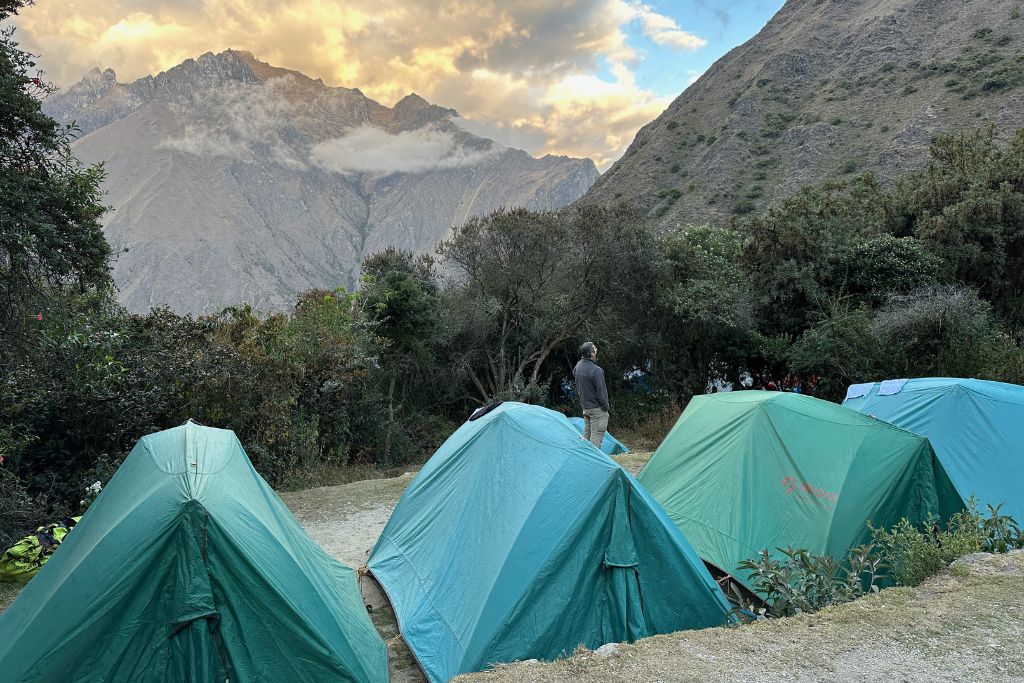
Day 2: The most difficult day
The highest altitude you’ll reach during your trek is today! At about 13.8k feet (4200 meters), this pass is quite intimidating. The whole hike today will be about 10 miles (16km) and will take you over the top of 2 mountain passes.
In my experience, it was incredibly difficult to get to the top of Dead Woman’s Pass. I was not fit and struggled the whole way up. But once you get there, it’s incredible. The views are astonishing. And you’ll know you’ve done the most difficult part of the whole 4 days already. It only gets easier from here.
You’ll have lunch in the valley between the two mountain passes, which gives you a nice break to take some rest and regenerate energy.
Then you’ll have to go over another mountain at 13k feet (4000 meters), but since you don’t go all the way back down after Dead Woman’s Pass, it’s a lot easier. From that pass, it’s all downhill. Literally.
At the end of day 2, right before camp, there are more ruins. It’s a steep staircase to get there, but honestly, it’s all worth it. Some people will skip these ruins and just want to get back to the camp. Fair enough. Callie skipped it, but I went up and explored.
I’d say it’s very much worth the extra 10 minutes, but it’s not as spectacular as some ruins on day 3. You’ll notice from this Alpaca Expeditions review that you’re free to do what you like. Your own pace, visit ruins or not, and bedtime is all up to you.
This was the day we spotted some Andean condors! The area near Machu Picchu is full of wildlife.
Day 2 difficulty: Hard
The first part of day 2 is hard. Very hard. But after you’ve hiked up and over the first pass, the second is very doable. It might even feel easy given what you’ve just had to do. The rest of the day is just a nice downhill to the camp. My legs ached after day 2. But looking back now, it was so worth it.
❗️ Book your Inca Trail with Alpaca Expeditions here!
Day 3: Natural beauty and ruins
Day 3 was my favourite day of the whole trek. You start the day with a gentle uphill hike through beautiful green scenery.
After 30 minutes you’ll reach the highest point of the day. And we know what this means! No more uphill! Right. This is not all in all true. There are some short and some gentle bits that go uphill. But generally, it’s downhill. All day, after the first 30 minutes.
Day three was very special. You can see the Amazon in the distance, and the towering mountains of the Andes all around you. The path just feels ancient. On day 2 some bits were gravel (not many though). But these are all stones laid by the ancient Incas. Your guide will tell you all about the foundation of these stones.
But it’s not just the natural beauty that makes this day so special. It’s also the ruins. You’ll see multiple beautiful ruins along the way. Some are even more spectacular than others. And after visiting all these amazing ruins, you’ll reach camp after a 6.2-mile (10km) hike mostly downhill.
At the campsite, you could encounter llamas, and there is yet another set of ruins right next to it.
Day 3 difficulty: Easy
Day three is mainly downhill. You’ll find many ruins along the way, and at each one, you get information about what might have happened at them. This breaks up the already quite easy hike which means you get to take breaks often.
The hike itself is also short. you don’t have lunch along the way like on days 1 and 2 but at the camp. It’s short enough not to need to have lunch halfway through. You get a good amount of time at the camp so you can rest and regain your energy for the final and most exciting day.
Day 4: The Sun Gate and Machu Picchu
The day you’ve been waiting for. You’ll finally reach Machu Picchu. You’ll wake up very early because when the gates of the trail open, you’re going to want to be the first to leave.
The faster you go the better. Because fewer people before you give the best views. Not to worry though, if you’re not the quickest, you’ll always have a guide with you. Plus, the views are the same. You just have to wait for your turn when you reach the Sun Gate.
Anyway. The hike is short and downhill until you get to the monkey stairs. They’re called this because they’re so steep, you have to use hands and feet to climb up them. When you reach the top of the stairs, it’s only a short, gentle uphill until the Sun Gate where you’ll lay first eyes on the magnificent Machu Picchu.
I’m not the most emotional person, but I teared up. What an incredible journey it has been. And how amazing that we finally made it. Even while writing this Alpaca Expeditions review, I get a little emotional just reminiscing the moment.
I also have to mention that for the most part, this hike is in darkness. It’s quite eerie, but also really exciting. When you reach the Sun Gate, it’ll be light, although the sun will still be behind the mountains.
When you then finally get to the top of Machu Picchu, a short hike after the Sun Gate, the sunbeams will start touching the stone ruins of the mountain city of Machu Picchu. An incredible sight.
Day 4 difficulty: Easy
This hike is the easiest and shortest of all. Only a few hours until you reach the Sun Gate and only the last part is a little uphill. This why you’re here. The adrenaline will kick in and give you a nice boost. You’ve also been exercising at altitude for 3 days, so it’ll feel noticeably easier than the first few days.
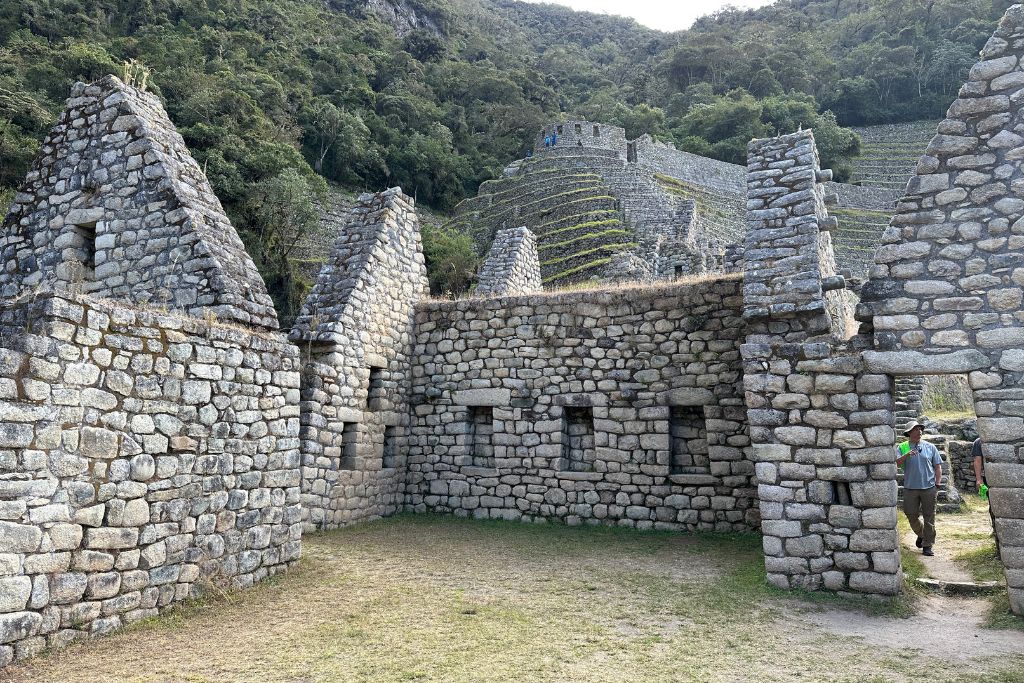
Alpaca Expeditions Review – The Food
I can absolutely not comprehend how the cook made all these incredible meals. Honestly. The table was filled with enough food for 15 people, and there were even leftovers. The cook made every meal on the floor in the kitchen tent, on a gas stove. And it was all delicious.
The meals were varied, from local dishes like lomo saltado to pasta. And, with Callie being vegan and me vegetarian, I was a little worried we were going to get less food. Which is what happens when you have different diets. But this is why I praise Alpaca Expeditions. There was a separate veggie version of every meat-based meal.
❗️ Book your Inca Trail with Alpaca Expeditions here!
And when those were not vegan, Callie got her own plate with a vegan version. So, not only did the cook have almost no space to prepare meals, he cooked varied meals, and even made 3 different versions of certain dishes so everyone could have the same food. I was amazed.
When we had pancakes for breakfast (I know, what a treat!), Callie got her own stack of vegan ones. Really, she would’ve been happy with some bread and jam, because we have to realise that being veggie or vegan comes with restrictions. Especially while travelling. But not with Alpaca Expeditions. This is yet another reason I’m writing this Alpaca Expeditions review.
They cater to any diet, be it lactose or gluten-free, vegetarian, or vegan. They do it all. And they do an amazing job.
Alpaca Expeditions Review – The Accommodation
I realise this is an important part of every trip: sleep. When you arrive at your camp for the night, the tents are already set up. When you leave, the tents will be broken down. All by the amazing team of porters.
You get a 2-inch thick sleeping mat included in the price of the trail. It’s not very thick, so you can opt to rent an air mattress as well. Honestly, we did not and we slept great. If you have back problems I’d go for the air mattress (which the porters carry for you), but otherwise, it’s not needed. The sleeping bags plus the 2-inch mat was plenty for us – and anyone else who didn’t rent an air mattress.
Their sleeping bags are very warm, I got way too hot in there and had to open them. The pillows are a little thin, but I rolled up a hoodie under it to make it more comfortable.
You’ll be so tired after all that hiking, that no matter what, you’ll sleep great anyway.
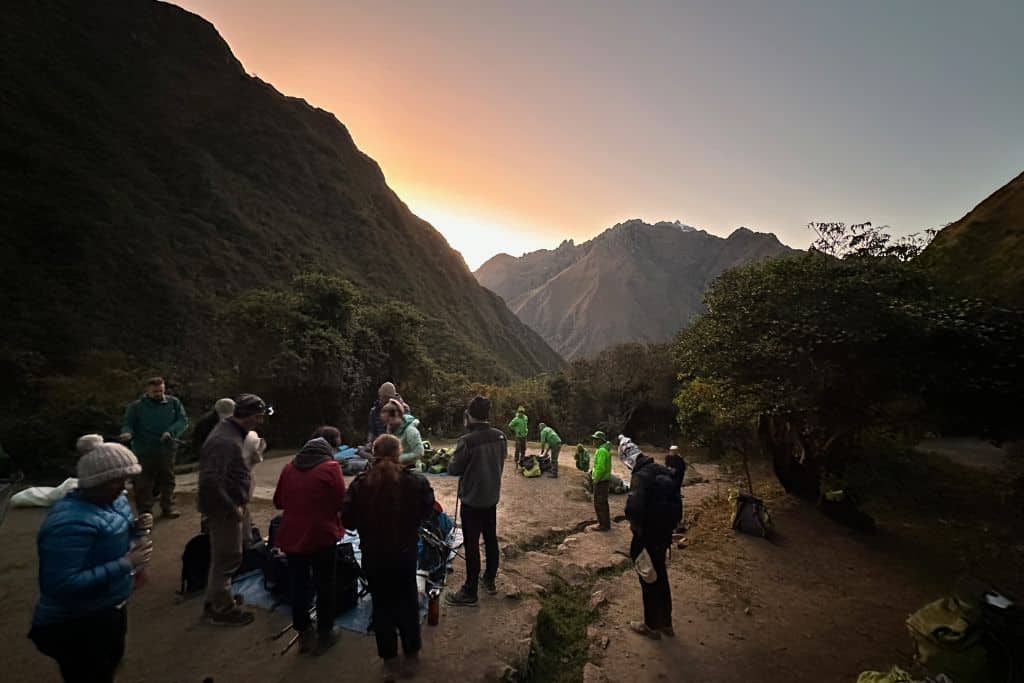
Alpaca Expeditions Review- Everything Else
From start to finish their communication was awesome. We were regularly updated, we got all the information we needed and more, and the briefing the night before was very detailed.
There was nothing more I could wish for on their part.
Their gear is in good shape, the tents are quality, and the trekking poles you can rent are in good condition. They treat their porters very well, which shows in their attitude along the trail. They’re smiling, happy, and eager to help with just about anything.
They have women porters which means they care about equality. They pay their staff well, and the guides were so knowledgeable and eager to give information, I couldn’t even think of any questions to ask. All our questions were answered before they were asked.
They are a little bit more expensive than the rest which could be a downside, but it’s worth it. And the difference is not much anyway.
Tipping
The only thing that I wasn’t too happy with was the tipping. We were told how much they expected us to tip the porters and cook during the briefing. I found that a little rude, but on the other hand it was nice to know what the expectations were. We were definitely going to tip, just quite less than they recommended.
I feel tipping should be based on experience, and not recommendations. So deciding how much to tip before having the experience is weird. But, I’m not from a tipping culture. So it could be different for people from the US, where tipping is quite standardised.
All in all it didn’t make much difference. And still, you get a private envelope without your name on it on the last night for your tips. You can still tip however much you want, and nobody will know and thus can’t judge your decision. But it then felt wrong to tip less than the recommendation.
The recommendation for tipping was:
- 60 soles for the porters (in total, not each)
- 120 soles for the cooks
- 50 soles for the guides
This added up to 230 SOL, which is about $60 per person at today’s rate (19th of February 2024). I know, not that much, but it did add up.
I reckon this is the same for the other companies though.
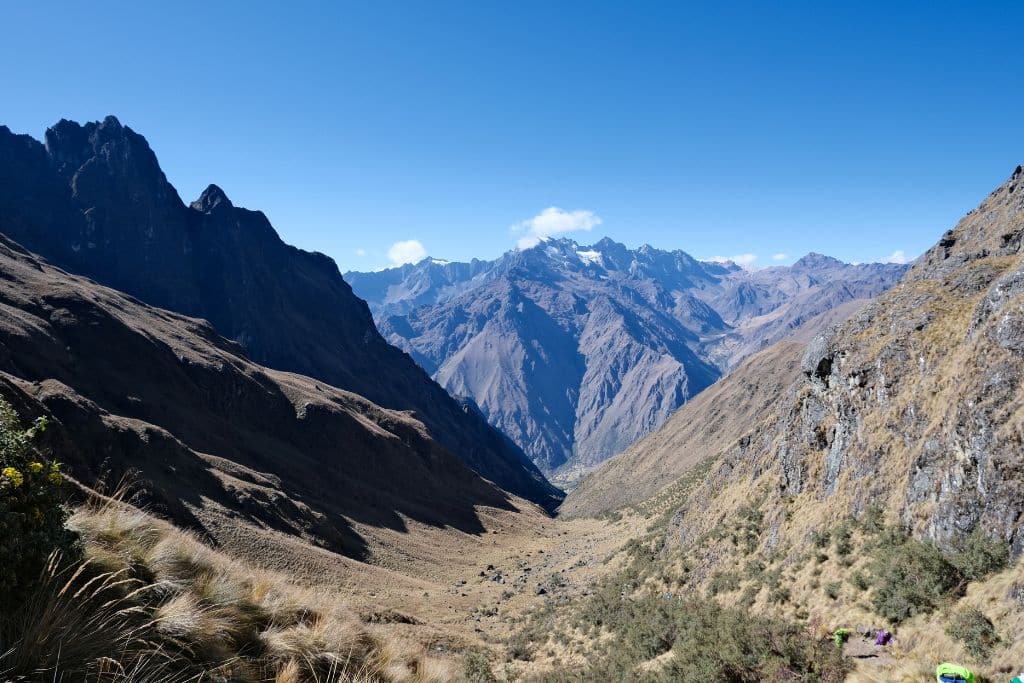
How to Prepare for the Inca Trail
The Inca Trail is not the hardest trek ever. But because of various reasons, a little preparation is necessary.
Packing list
We were on a 10-month backpacking trip, so we had to buy some essentials in Cusco. Especially if you’re on a longer Peru trip, you might carry more than you need just for the Inca trail. Or you might forget to pack stuff.
What to pack is the main question many people have. These are my recommendations.
For your daypack:
- Passport – otherwise you won’t get access to the trail or Machu Picchu
- Immigration card – you get this while entering the country
- Storage for at least 1,5L of water – Camelbak or similar recommended (you need your own water before lunch on day 1, the rest is provided)
- Good hiking boots
- Headlamp
- Sunglasses
- Snacks
- Powerbank to charge devices: there is no electricity along the trail
- Raincoat
- Gloves
- Warm hat
- Sun hat
- Space for any layers you take off during the day
- Toiletries: hand sanitiser, sunscreen, painkillers, bug spray, personal medication, female hygiene products, blister plasters
- Rehydration sachets
- Altitude sickness tablets
For the duffel bag (max 7kg):
- 2 or 3 t-shirts
- A warm coat or a thick hoodie/poncho
- Extra layers for the mornings and evenings
- Quick drying towel
- 3 pairs of hiking socks
- Extra pair of shoes for the camps
- Extra pants
- Comfy pants for the camp
- 4 pairs of underwear
- Sports bras are recommended (according to Callie, I wouldn’t know!)
- Toiletries: wet wipes, toothbrush and paste, soap
Is being fit necessary?
Yes, but you don’t have to be an athlete or anything. We’re not really fit, but we hike occasionally. We struggled on day 2 because of the climb and altitude but were fine the rest of the time.
If you can go on moderate hikes, you will be fine.
Do a few hikes beforehand
Check your fitness by hiking at home. If you’re comfortable doing 10-mile (16km) flat hikes, or slightly shorter ones with hills, you are going to be absolutely fine!
The problem on the Inca trail is not necessarily the hike, it’s more the altitude.
Prepare for your hike by acclimating
Before you do the Inca Trail, or any other trek or hike near Cusco for that matter, you need to acclimate. It’s very dangerous if you don’t. Altitude sickness is no joke.
If you don’t acclimate, Alpaca Expeditions will not let you come on the hike, and won’t refund you.
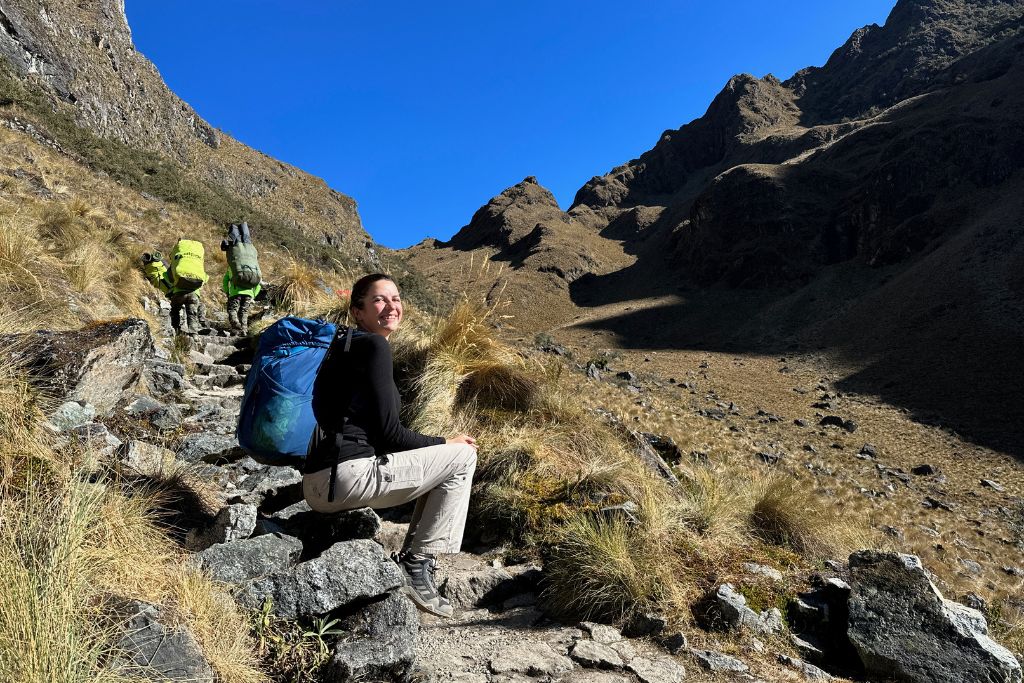
Stay hydrated
Hydration is a key factor during the Inca Trail. It helps with altitude sickness and will make you feel better in general. You’re ‘just’ hiking, but because of the altitude, it’s strenuous exercise. It may be cold, but your heart will be racing and you will still sweat.
Drink Coca Tea
Coca leaves are what the ancient Incas, and today’s population, use for altitude sickness and energy. You’ll see porters chewing the leaves, but mostly, people make coca tea. I understand this can sound a little dodgy. Coca leaves contain traces of cocaine. But in such small amounts that it’s not dangerous at all.
Nearly everybody uses coca leaves. It’s legal in Peru. Cocaine is not, so there is definitely a difference between the two. You get a bigger buzz from a cup of coffee, to be honest.
The only warning I’d like to give: if your job requires random drug testing like some do, maybe don’t have coca leaves. It could show up as cocaine in urine for 24 hours. Now, I don’t think you’ll be at work within 24 hours of finishing the Inca Trail, but still.
Best Time of the Year to Hike the Inca Trail
The best time to visit Cusco is different depending on what you’re after. But, If you’re doing the Inca Trail, the months of May till July are the best, and thus most popular. This means you have to book well in advance. Months, or even a year.
Booking in advance guarantees your spot. Only 500 people are allowed onto the Inca Trail per day. And this includes porters, guides, and tourists. Our group had 15 tourists, but including everyone, we had 38 people. This means about 200 tourists are allowed per day. And in the popular months, this fills up.
How Much Does it Cost to Do the Inca Trail?
I’ll tell you exactly what we paid for the Inca Trail. This will NOT include transport to Cusco, nor the time spent there beforehand.
- The Inca Trail 4N/3N – $1590
- Hiking poles rent 1x – $20
- 2 sleeping bags rent – $50
- Tips – $131
- 2 Camelbaks – $105
- Toiletries – $9
- Beers along the trail – $6.50
- Toilet charges – $7
In total: $1918. This was for two people, which makes the price per person about $960.
FAQs – Alpaca Expeditions Review & Inca Trail
We’ve discussed how the Inca Trail works. We’ve discussed why Alpaca Expeditions is a great company to choose. Now let’s discuss even more!
Is travel insurance necessary for the Inca Trail?
It’s not mandatory, but it is highly recommended. The Inca Trail is not necessarily dangerous, but it is expensive. If anything happens during or before your trip, your travel insurance will usually cover the costs. I’d say this is worth it.
Are trekking poles necessary for the Inca Trail?
Trekking poles are not necessary. We rented 1 pair to share and didn’t use them at all. Others in our group used them the whole way. So it really depends on personal preference.
If you take your own trekking poles, make sure they have rubber feet, otherwise, you are not allowed to use them to protect the trail.
How long can you spend at Machu Picchu?
We spent about 3,5 hours in Machu Picchu, of which 2 hours was a tour of the city. that includes the initial photos from the top, which is technically not inside Machu Picchu yet.
Is setting up my tent required every day on the Inca Trail?
Nope! Your tent will be set up by a fantastic team of porters!
What is the toilet situation like along the Inca Trail?
There are some toilets along the way, but not many. They often cost 1-2 Soles. The ones on the campsites, if there are any, are free.
Alpaca Expeditions also has portable private toilets for emergencies and for the night on campsites.
Other than those, you’ll have to use the Inca toilets: the bushes.
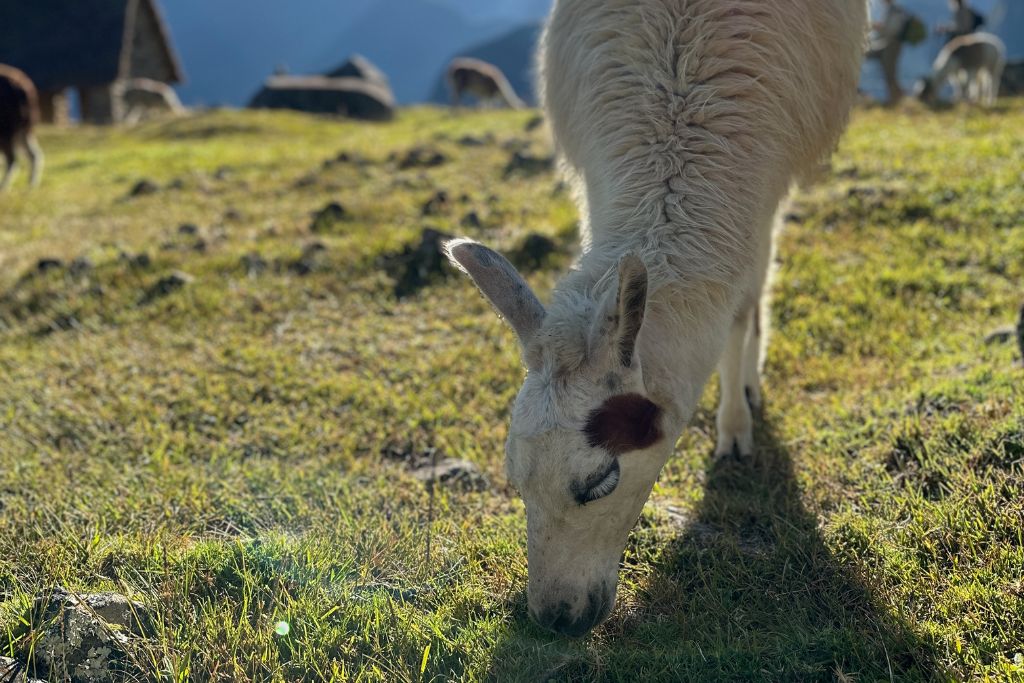
Is the Inca trail to Machu Picchu hard?
It’s quite challenging. But I only found the first 1,5 days hard. After you reach the first mountain pass on day 2, the rest feels easier.
It can be quite hard mentally. You’ll be constantly overtaken by porters, which makes it seem like you’re slow. Remember: everybody has their own pace. You will have 2 guides, one in front, and one in the back. You’ll never be left behind, because the second guide will stay with the last person in the group.
How far is the Inca Trail to Machu Picchu?
The classic Inca Trail takes 4 days and 3 nights. The total distance is 23 miles (45km). This includes the walk to Machu Picchu on the final day. The distance you hike each day varies, but the longest day is about 10 miles (16km).
Can you do the trail without a guide?
You can not do the trail without a guide. You have to take a tour. The guides make the experience even better by telling you all about the history of the ruins you encounter, including Machu Picchu.
How much money should I bring with me on the Inca trail?
I recommend taking some cash to pay for the occasional toilet, and to buy snacks and drinks along the way. On day 1 you’ll pass a few people selling things, and on day 2 is your last chance.
We bought 2 beers on day 2 as a reward for finishing the hardest day. Nothing better than a cold beer after a hard day, right?

Final Thoughts – Alpaca Expeditions Review
All in all, trekking the Inca Trail with Alpaca Expeditions is a transformative experience that combines the physical challenge of the hike with the profound beauty of ancient Incan history. Their knowledgeable guides, supportive staff, and well-organized itinerary ensure that every step of the journey is not only manageable but also immensely rewarding.
Whether it’s the breathtaking views, the friendship among hikers, or the personal sense of achievement, the memories you create on this trail are guaranteed to be as enduring as the stones laid down by the Incas centuries ago. So, lace-up your hiking boots, and prepare for an adventure that you’ll reminisce about for years to come!

